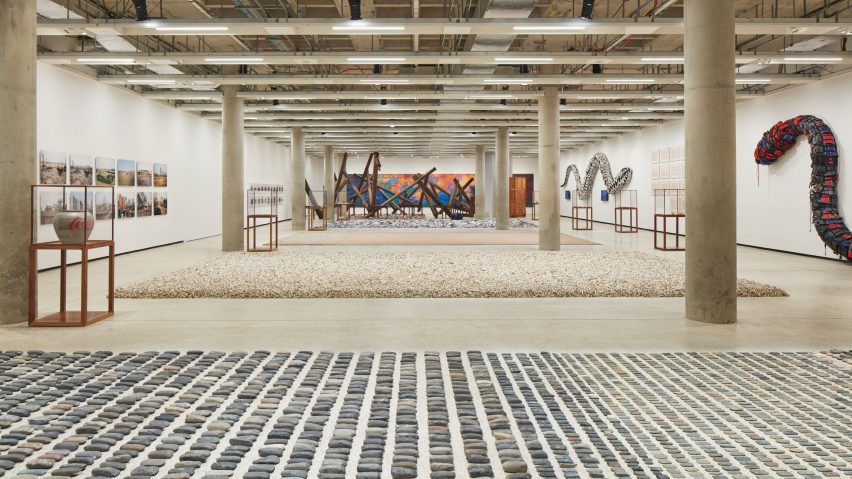Hundreds of thousands of cannonballs, donated Lego bricks and a marble toilet roll feature in Making Sense, the first design-focussed exhibition by Chinese artist Ai Weiwei at London's Design Museum.
Showing a range of new and historical works spread across a single gallery, Ai Weiwei: Making Sense opens at the Design Museum this Friday and marks the artist's first design-focussed exhibition to date.
"I had to do something after the pandemic to celebrate how life goes on," explained Ai, who is globally recognised for using art as a tool for activism.
Central to the space is five "field works" made from rectilinear arrangements of found objects that the artist has been collecting since the 1990s.
Still Life is a group of several thousand Stone Age axe heads, knives, spinning wheels and chisels sourced from flea markets and laid side-by-side. The installation intends to humble visitors and serve as a reminder that design was originally based on survival.
Another untitled work created last year brings together over 200,000 Xing ware porcelain cannonballs made during China's Song dynasty – seemingly delicate objects that were once war weapons.
"It's a matter of intelligence," Ai told Dezeen, discussing his long history of collecting artefacts.
"It is to keep the memory and to try and build yourself with what has happened to other human beings in very dramatically different times through history."
Spouts is an installation of thousands of ancient porcelain teapot spouts, while Left Right Studio Material collects fragments of Ai's sculptures that were destroyed by the Chinese state when it demolished the artist's Beijing studio without warning in 2018.
"The remains are a form of evidence of the repression that Ai has suffered at the hands of the Chinese government, as well as a testament to his ability to turn destruction into art," said the Design Museum.
The fifth "field work" features piles of Lego bricks that were donated by members of the public after the toy manufacturer stopped supplying bricks to Ai because he used the toys to create portraits of political prisoners.
Called Lego Incident, the work is presented alongside a vast recreation of French impressionist Claude Monet's famed Water Lillies series that is also made entirely out of Lego, as well as a dramatic wooden sculpture made of columns sourced from a Qing dynasty temple and tables from the same period.
Among the other pieces in the exhibition, the artist presented a pair of large sculptures made from life jackets and children's school bags respectively.
The objects were arranged in two snake-shaped formations dedicated to the victims of China's 2008 Sichuan earthquake and the ongoing refugee crisis in Europe.
Also on display are two life-size toilet rolls made from marble and glass, which were designed in 2020 in response to our dependency on everyday objects at the start of the coronavirus pandemic.
"They work as one," said Ai, who said he does not have a favourite piece in the exhibition – rather, he feels the projects complement each other.
"All my works work as one – the bad ones, the so-called 'good' ones, the random ones or the ones being neglected."
"It's just like, can you choose one part of your body as the most important one?"
Various photography was also shown, including colourful new editions of the artist's Study of Perspective series – images of the artist pointing his middle finger at recognisable landmarks including Berlin's Reichstag building and New York's Trump Tower.
Prints displaying the National Stadium, widely known as the Bird's Nest, being constructed prior to the 2008 Beijing Olympics were also mounted to the wall.
While the artist helped to conceive the stadium in collaboration with architecture studio Herzog & de Meuron, he later distanced himself from the project in protest against the Chinese government.
"I never really have a particular hope," said Ai. "I just focus on my own practice," he said discussing how he would like audiences to engage with the exhibition.
"I think it's a good idea to present to others as people may share the same kind of emotions or concepts [to you]. But I have no idea – I just don't know."
Other recent projects contained in Ai's extensive portfolio of political work include a cage-like structure in Stockholm and a Quebec City installation made of a wall of life jackets that were used by Syrian refugees while attempting to cross the Mediterranean sea.
The photography is by Ed Reeve unless otherwise stated.
Ai Weiwei: Making Sense is on display at London's Design Museum from 7 April to 30 July 2023. See Dezeen Events Guide for an up-to-date list of architecture and design events taking place around the world.

